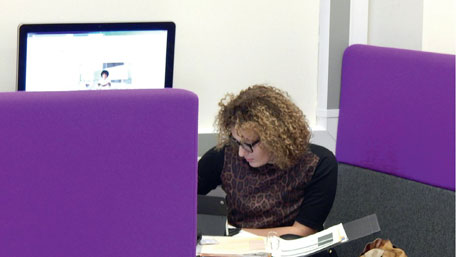Designing college libraries for Generation Z
Generation Z students are 'the first tribe of true digital natives' or 'screengagers', demanding more from the library space than their predecessors.
In this article written by Demco Interiors for Designing Libraries, we look at some of the design considerations when marrying technology to space and furniture design for students who now interact with library services in new ways.

Some interesting insight emerged from research Demco carried out with college librarians in 2014 to find out more about the issues college libraries face in delivering library services to Generation Z students. The aim was to uncover hot spots and trends that might shape the development of products and services, and inform the design of interactive library spaces. The researchers followed library design conversations on social media, interviewed delegates at conferences and events, digested a number of reports, and analysed recent design projects. Three distinct themes emerged.
Intuitive Design
The main thing about intuitive design is that it should be ‘invisible’. Design is intuitive when users can interact without interruption, directing their attention to important focal points. An intuitive design centres on the experience rather than the process. Years of designing, furnishing and resourcing library spaces has been built into Demco’s understanding of how a space can be configured to make it intuitive. Colours, lighting, furnishings can subliminally direct students to what they need to find and where they want to be.
Intuitive designs are not formal, they hand ownership of the space to the user. It’s a concept that might be described as ‘together:alone’ – an intuitive design combining individual study with group activities, but without boundaries or restrictions. Intuitively designed spaces are relaxing and pleasant to be in, which in turn makes them motivating and inspiring. So any design commissioned for a new library or resource centre should include ‘intuitive design’ as part of the consultation and presentation brief.

Managing the space
Technology, and how to manage the shift to mobile devices, came out as a strong theme in discussion. As learning methods evolve, there are demands for further support such as power sockets, mobile device chargers, group study hubs, iPad and tablet loan and storage facilities. Furniture solutions incorporating extra sockets and charger points are essential. Mobile units and screening, interconnecting and folding tables, stackable chairs, mobile ‘power towers’, iPad stands and trolleys, all become ‘part of the furniture’ of a modern, accessible library space: “I’m looking for integration between the different areas. Our students have laptops, or they’re at a computer, but they also have files, papers, pens, the whole thing, so we need to have space that is big enough.”
An intuitive design with intuitive resources can reduce time spent on managing the space and provide more time to support students. The aim is to create a self-managing space where students can self-issue media, book the workspaces they need, hire laptops – and the management software supporting these functions will provide useful data to drive future resource decisions.
Newer libraries are beginning to integrate other services, particularly where campuses are merged, such as careers services, study skills, hospitality, cafe, chill spaces, demonstration and production spaces. Flexibility is key, with furnishings that can easily be constructed and dismantled without the need for special tools, special skills, or muscular staff and student help.

Preparing students for their futures
The library or resource centre supports the college strategy to deliver high quality courses and training for a broad universe of students. The college librarians interviewed were universal in their commitment to help students bridge the gap between a learning and an earning environment, narrowing the leap from college to work. And the nature of courses has changed considerably, with more group presentational style of study than heads down individual study, and that too impacts on design thinking. Learning booths are becoming increasingly popular for meeting semi-private group or individual working styles, and even board room style layouts with presentation screens give students the experience of presenting their ideas in a ‘corporate’ environment. In the past, the gap between a college library space and an office space was very marked, but the gap has narrowed and some higher education resource centres are now not far removed in look and style from Google’s new offices.
When designing and furnishing new spaces the question to ask is: Do students want to be there? Or is it simply that they have to be there? It amounts to a big difference.
A final word from Michaela Lancaster, Senior Design Manager, Demco Interiors: “Generation Z students have a keen eye for design and they want to hook up and set down in cool spaces that motivate and inspire. Our role is to bring all the strands together to create functional spaces that zing with imagination and creativity and make students want to be there.”
A version of this article appeared in the CILIP Buyer’s Guide, 2015.